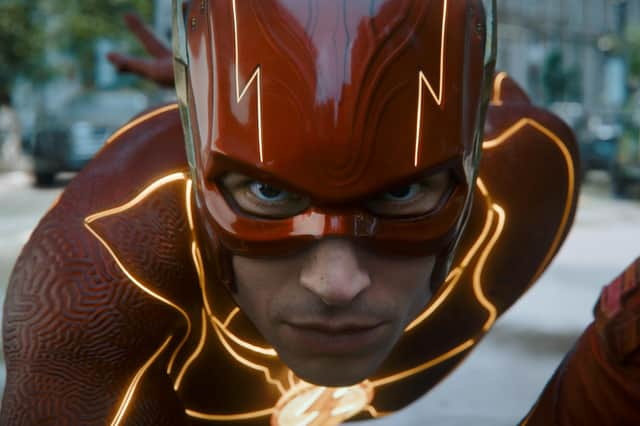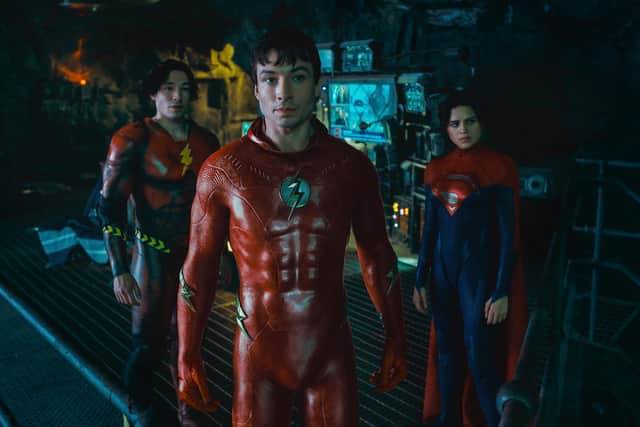Film reviews: The Flash | Extraction 2


The Flash (12A) ****
Extraction 2 (15) ***
Delayed by covid and almost torpedoed by the erratic off-screen behaviour of its star Ezra Miller, The Flash arrives in cinemas in surprisingly robust shape given its beleaguered history. Essentially the concluding chapter in DC’s haphazard effort to create a so-called “Extended Universe”, it plays around with the currently in-vogue concept of the multiverse to bring back Michael Keaton’s Batman while also paying tribute to other iconic (and not-so-iconic) performances from DC screen adventures past and present.
Keaton, of course, was also supposed to be in the scrapped Batgirl movie and the irony of its cancellation is hard to ignore when confronted with a film that literally erases whole swathes of the DC universe as part of a reality disrupting time-travel plot. It’s also an irony made more acute by the fact Batgirl was shot entirely in Glasgow just a few months after The Flash commandeered the city centre for its own spectacular Gotham-set opening salvo.
Advertisement
Hide AdThat opening re-introduces us to the film’s eponymous hero, the red-suited, super-speedy alter ego of twenty-something forensic scientist Barry Allen (Miller). Still dismissively thinking of himself as the “janitor” of the Justice League, he’s affectionately tolerated by Ben Affleck’s Batman, with whom he shares a similarly tragic origins story, having lost his own mother in a senseless murder for which his father, played by Ron Livingston, has been erroneously imprisoned.
The new film starts with the Affleck Batman tearing through Gotham on his Batpod while the Flash does the grunt work of rescuing some babies from a collapsing hospital building. In juxtaposing this gnarlier, older Caped Crusader with the kitschy sight of Miller’s juvenile, jittery hero zipping through the air catching screaming infants as they fall to the ground in ultra slow motion (“a baby shower!”) director Andy Muschietti (the It movies) provides a good indication of the balancing act he’s is trying to pull off.
This is a movie much lighter in tone than Batman vs Superman: Dawn of Justice, yet like that film, it’s also sincerely exploring its titular hero’s efforts to reckon with both his own painful past and the god-like power so-called “meta-humans” have to both save and destroy the world. In the Flash’s case this dilemma comes about as he realises his speedy powers allow him to travel through time, and the film really kicks into gear when Barry gets stranded in a past where his parents are not only still together but he’s still a college student yet to be subjected to the lab accident that will confer super-powers upon him. The bulk of the second act is built around Barry guiding this feckless alternative self towards his destiny as a superhero. Luckily, seamless digital trickery and two entertainingly distinct comic performances from Miller ensure it’s breezily done, with Muschietti leaning into the plot similarities to Back to the Future Part II with an overt joke about actor Eric Stoltz (whom Michael J Fox replaced as Marty McFly).


But this timeline is also under threat because there are no super-powered heroes to stop Kryptonian villain General Zod (Michael Shannon). His appearance echoes his arrival in Man of Steel and is explained away as one of those canonical events that always happen regardless of how messed up the timeline gets — an intriguing idea the film coincidentally shares with current mega-hit Spider-Man: Across the Spider-Verse. Sadly, Muschietto can’t resist using it to deliver one horribly extended fan-servicing tribute scene that plays like a bad museum exhibit come to life. And yet, this multiverse aspect also allows for the return of Keaton’s long-since retired Batman. Clearly relishing the chance to reassert his prowess as the original cinematic Dark Knight, it’s certainly a joy to see Keaton recapture the weirdo glint that made Tim Burton’s Batman films so distinctive.
The film has a lot of surprises up its sleeve, but aside from Keaton’s turn, it’s at its best when focussing on Barry Allen’s journey. His dual existence starts driving the plot in intriguing way as he tries over and over to fix things, only to keep making them worse. If that makes for a messy film in places, it also works as a commentary on the do-over nature of superhero filmmaking. Every new version of a story risks ruining what people love, but even the catastrophes can deliver things audiences didn’t even know they wanted – a point the Flash audaciously rams home in its final moments with the best gag of the film.
Starring Chris Hemsworth as an emotionally catatonic mercenary with the skills to get the kills, Netflix’s 2020 action thriller Extraction was a no-nonsense affair with one moment of levity: Hemsworth’s character was called Tyler Rake and, at one point, he got to kill someone with an actual rake. That gag becomes a point of pride in Extraction 2. Shovels, screwdrivers, nails and hacksaws are all utilised in various fights to the death, though in an effort to scale things up, the film also finds fatal uses for gym equipment (including a particularly inventive use of a treadmill), as well as more traditional weaponry, such as knives, guns and the odd rocket launcher.
Advertisement
Hide AdConsequently, the bloodshed is even more extreme, but returning director Sam Hargreaves also ups the ante on the first film’s single-shot action sequences with an insanely complex, seamlessly executed 20-minute oner that goes from a prison break to a car chase to a combat assault on a runaway train with no discernible cuts. The generic story is less inspired, but the action hits hard and Hemsworth is a gruffly efficient lead.
The Flash is in cinemas from 14 June; Extraction 2 streams on Netflix from 16 June.